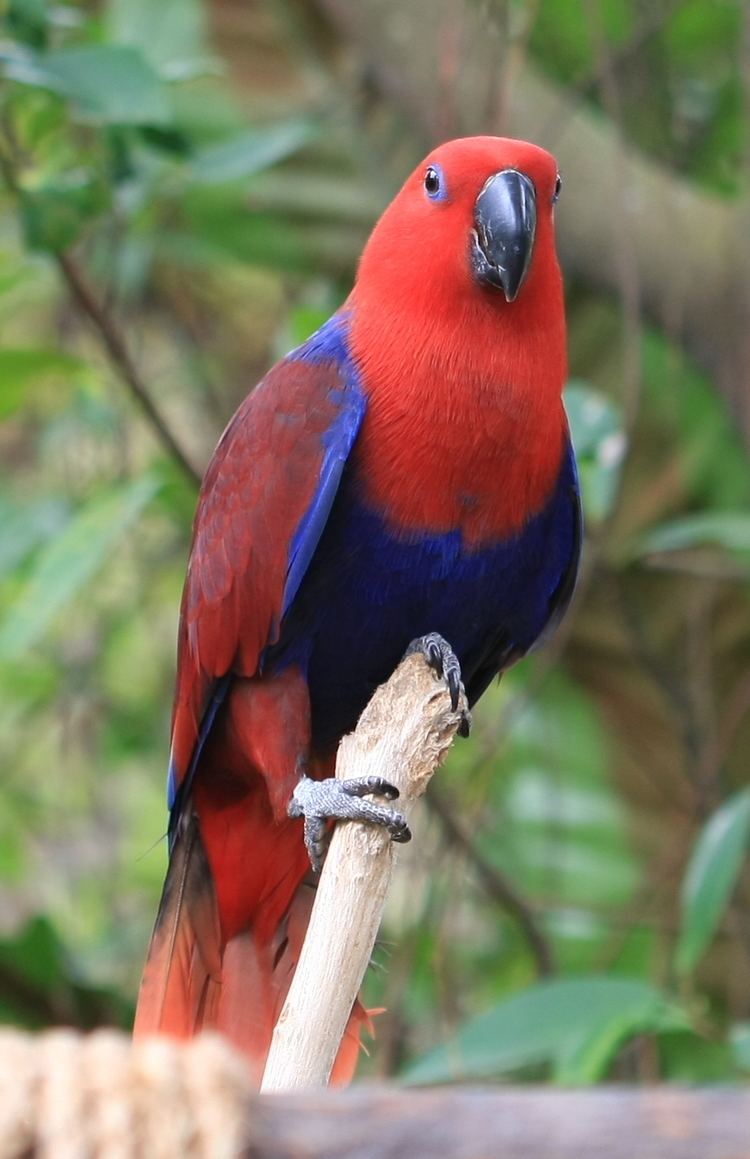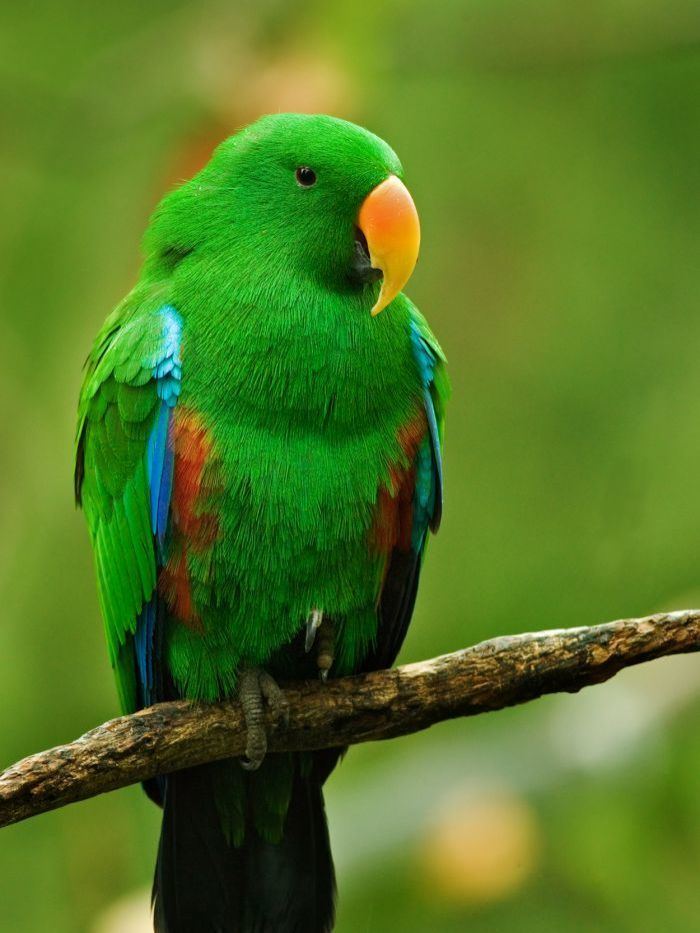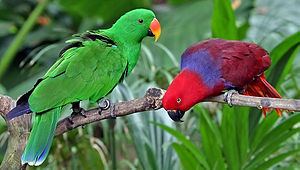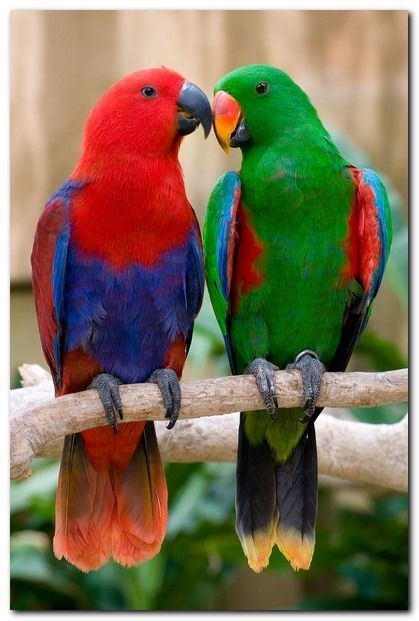Rank Species Order Parrot | Superfamily Psittacoidea Subfamily Psittaculinae Genus Eclectus Phylum Chordata | |
 | ||
Similar Parrot, Bird, African grey parrot, Cockatoo, Pionus | ||
Behavioural problem in eclectus parrot with randy bird syndrome 1 220710
The eclectus parrot (Eclectus roratus) is a parrot native to the Solomon Islands, Sumba, New Guinea and nearby islands, northeastern Australia and the Maluku Islands (Moluccas). It is unusual in the parrot family for its extreme sexual dimorphism of the colours of the plumage; the male having a mostly bright emerald green plumage and the female a mostly bright red and purple/blue plumage. Joseph Forshaw, in his book Parrots of the World, noted that the first European ornithologists to see eclectus parrots thought they were of two distinct species. Large populations of this parrot remain, and they are sometimes considered pests for eating fruit off trees. Some populations restricted to relatively small islands are comparably rare. Their bright feathers are also used by native tribespeople in New Guinea as decorations.
Contents
- Behavioural problem in eclectus parrot with randy bird syndrome 1 220710
- Eclectus parrot singing and talking
- Taxonomy
- Subspecies
- Dubious subspecies
- Description
- Diet
- Breeding
- Aviculture
- References

Eclectus parrot singing and talking
Taxonomy

Ornithologists usually classify the eclectus parrot as a member of tribe Psittaculini in the family Psittacidae of order Psittaciformes. However, some recent thought indicates that there is a great deal of commonality between the eclectus parrot and the Lorini tribe.

Sir D'Arcy Wentworth Thompson noted there were similarities in the skull between the eclectus parrot and members of the genus Geoffroyus, specifically in the auditory meatus and the prefrontal reaching but not joining the squamosal bones. The skull of members the genus Tanygnathus is also generally similar.

The eclectus parrot is the most sexually dimorphic of all the parrot species. The contrast between the brilliant emerald green plumage of the male and the deep red/purple plumage of the female is so marked that the two birds were, until the early 20th century, considered to be different species.

Although the eclectus parrot is the only extant species in the genus Eclectus, fossil remains of another species, Oceanic eclectus parrot (Eclectus infectus), have been found in archaeological sites in the islands of Tonga and Vanuatu. The species presumably existed in Fiji as well. E. infectus had proportionally smaller wings than the eclectus parrot. The species became extinct after the arrival of humans 3000 years ago, presumably due to human-caused factors (habitat loss, introduced species).
Subspecies

There are nine (possibly more) subspecies of eclectus parrots, although the species as a whole needs reviewing. Access to some regions where the species occurs is difficult due to geographical or political reasons, and hence field observations have been limited. Furthermore, many skins were collected in the early part of the 19th century and have deteriorated in some museums. However, most eclectus skins in US museums are in good condition. In captivity in the U.S., some of the most common subspecies are the Solomon Island, the Vosmaer's, and the New Guinea Red-sided.

Dubious subspecies

Description

The eclectus parrot is unusual in the parrot family for its marked visible light sexual dimorphism in the colours of the plumage. A stocky short-tailed parrot, it measures around 35 cm (14 in) in length. The male is mostly bright green with a yellow-tinge on the head. It has blue primaries, and red flanks and underwing coverts. Its tail is edged with a narrow band of creamy yellow, and is dark grey edged with creamy yellow underneath, and the tail feathers are green centrally and more blue as they get towards the edges. The grand eclectus female is mostly bright red with a darker hue on the back and wings. The mantle and underwing coverts darken to a more purple in colour, and the wing is edged with a mauve-blue. The tail is edged with yellowish-orange above, and is more orange tipped with yellow underneath. The upper mandible of the adult male is orange at the base fading to a yellow towards the tip, and the lower mandible is black. The beak of the adult female is all black. Adults have yellow to orange irises and juveniles have dark brown to black irises. The upper mandible of both male and female juveniles are brown at the base fading to yellow towards the biting edges and the tip.
The above description is for the nominate race. The abdomen and nape of the females are blue in most subspecies, purple abdomen and nape in the subspecies (roratus) and lavender abdomen and nape in the (vosmaeri) subspecies from the north and central Maluku Islands, and red abdomen and nape in the subspecies from Sumba and Tanimbar Islands (cornelia and riedeli). Females of two subspecies have a wide band of yellow on the tail tip, riedeli and vosmaeri which also have yellow undertail coverts. The female vosmaeri displays the brightest red of all the subspecies, both on the head and body.
Diet
The diet of the eclectus in the wild consists of mainly fruits, wild figs, unripe nuts, flower and leaf buds, and some seeds. In captivity, they will eat most fruits including mangos, figs, guavas, bananas, melons, stone fruits, grapes, citrus fruits, pears, apples, pomegranate and papaya (pawpaw). The eclectus has an unusually long digestive tract and this is why it requires such a high fiber diet. In captivity the eclectus parrot does benefit from a variety of fresh fruits and vegetables, leafy greens such as endive and dandelion, as well as a variety of seeds, including spray millet, and a few nuts such as shelled almonds and shelled walnuts.
Breeding
In its natural habitat, the eclectus nests within hollows in large, emergent rainforest trees. Suitable hollows are at a premium and the hen will vigorously defend her chosen nesting site from other females (perhaps even fighting to the death), remaining resident at 'her tree' for up to 11 months of the year, rarely straying from the entrance to her hollow and relying on multiple males to feed her via regurgitation. Males may travel up to 20 km to forage and up to five males will regularly provide food for each female, each competing with the others for her affections and the right to father her young. Unlike other parrot species, eclectus parrots are polygynandrous—females may mate with multiple male suitors and males may travel from nesting site to nesting site to mate with multiple females. This unique breeding strategy may explain the pronounced sexual dimorphism of the eclectus, as it is the female which must remain conspicuous at the entry to the nest hole, (in order to advertise her presence at her hollow to males and rival females), but well hidden when in the depths of the nest, because the red color hides her well in the darkness. The male is primarily a brilliant green color, which offers camouflage amongst the trees whilst foraging. However, the plumage of both sexes appears spectacular when viewed in the ultraviolet spectrum, an ability which predators such as hawks and owls lack.
Two white 40.0 mm × 31.0 mm (1.57 in × 1.22 in) eggs are laid, which are incubated for 28–30 days. Young fledge at about 11 weeks of age. Although eclectus parrots may reach sexual maturity earlier or later, they usually reach it between 2–3 years.
Eclectus hens have a strong maternal instinct, which is displayed in captivity where they will constantly seek possible nesting spaces, climbing into cupboards, drawers and spaces beneath furniture and becoming very possessive and defensive of these locations. An unpaired hen may go on to lay infertile eggs with little encouragement in the spring. It is often possible to place abandoned eggs from other parrot species beneath a broody eclectus hen, which she will readily accept and then happily incubate to the point of hatching and even rearing the hatched chick to the point it is removed from the nest.
Adult females with poor nest hollows often commit infanticide on the male, if they produce both a male and a female chick. Inadequate nest hollows have a habit of flooding in heavy rain, drowning the chicks or eggs inside. This reported infanticide in wild pairs may be the result of other causes, since this behavior is not observed in captive pairs where the hen selectively kills male chicks.
Aviculture
Eclectus parrots are one of the more popular birds kept in captivity, as either parent or hand reared. Unlike many other species of parrot they are relatively easy to breed yet difficult to hand feed. Eclectus in captivity require vegetables high in beta-carotene, such as lightly cooked sweet potato, fresh broccoli clumps, and fresh corn on the cob. Fresh greens such as endive or commercial dandelion are very important in providing calcium and other nutrients. As with all pet birds, they should not be fed avocado, chocolate, or high fat junk foods such as French fries or commercially processed human foods such as pizza. Parrots are unable to digest the lactose in milk. Spray millet is one of the seed items they enjoy, though the eclectus diet should typically contain much less seed than other birds. A variety of soaked and cooked beans and legumes, along with brown rice, provided in limited amounts help provide protein. Nuts and seeds provide vitamin E, but should be limited in order to avoid too much fat in the diet, as eclectus parrots can become obese.
The captive eclectus can be susceptible to muscle spasms known as toe-tapping and wing flipping. While all the causes are not clear, a major cause is a chemical imbalance in vitamins and minerals which inhibits the uptake of calcium, which often occurs subsequent to feeding commercially produced food treats or a high proportion of pellets in the diet. These movements have not been observed in the wild. Potential causes include consumption of pellets or other foods that are overly fortified with man made vitamins or artificially colored, or even simple dehydration. [Dr. Debra McDonald, avian nutrition researcher, has discussed the effect of man made vitamin A on the uptake of calcium.] Fortified or artificially colored food items may also cause allergic reactions in some individuals, including severe itchiness leading to feather and skin damage.
Eclectus parrots are generally calm birds in captivity, displaying a pensive nature when faced with novel items or situations, which may give rise to the mistaken impression that the species is 'dull-witted'. The eclectus may also exhibit a more neophobic nature than other species of companion bird. Eclectus parrots are prone to feather destruction (picking, pulling, cutting and or barbing) in captivity. Causes can be difficult to pin down, but diet is generally the primary cause, along with failure to provide a soft wood perch to chew, with health problems and hormonal changes thought to be additional causes, as well as clipping primary wing feathers so that the cut ends irritate the bird's sides. Once this behavior begins it is nearly impossible to stop unless the cause has been addressed. Often only a mechanical barrier (e-collar) is successful in keeping the afflicted parrot from completely stripping all but its head of feathers. Other captive species that are prone to this behavior are the cockatoo, African grey, and to some extent the macaw.
Many eclectus parrots in captivity in Australia are apparently hybrids between subspecies polychloros and solomonensis, as Sydney's Taronga Park Zoo had a flock of these in a large aviary many years ago. Specimens of the Australian subspecies macgillivrayi have only recently entered the aviculture market in Australia and are more expensive.
The average lifespan of the eclectus parrots in captivity is unknown, since these birds were not kept in captivity in great numbers until the 1980s. Some sources consider the lifespan to be 30 years. The maximum reliably recorded longevity for this species is 28.5 years, however a lifespan of 40.8 years has also been reported.
